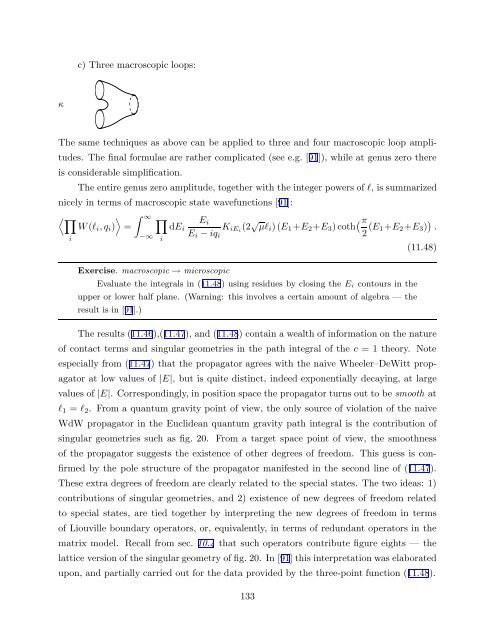arXiv:hep-th/9304011 v1 Apr 5 1993
arXiv:hep-th/9304011 v1 Apr 5 1993
arXiv:hep-th/9304011 v1 Apr 5 1993
Create successful ePaper yourself
Turn your PDF publications into a flip-book with our unique Google optimized e-Paper software.
c) Three macroscopic loops:<br />
κ<br />
The same techniques as above can be applied to <strong>th</strong>ree and four macroscopic loop amplitudes.<br />
The final formulae are ra<strong>th</strong>er complicated (see e.g. [91]), while at genus zero <strong>th</strong>ere<br />
is considerable simplification.<br />
The entire genus zero amplitude, toge<strong>th</strong>er wi<strong>th</strong> <strong>th</strong>e integer powers of l, is summarized<br />
nicely in terms of macroscopic state wavefunctions [91]:<br />
〈∏ 〉 ∫ ∞ ∏ E i<br />
W (l i , q i ) = dE i K iEi (2 √ µl i ) (E 1 +E 2 +E 3 ) co<strong>th</strong> ( π<br />
E i − iq i 2 (E 1+E 2 +E 3 ) ) .<br />
i<br />
−∞<br />
Exercise. macroscopic → microscopic<br />
i<br />
Evaluate <strong>th</strong>e integrals in (11.48) using residues by closing <strong>th</strong>e E i contours in <strong>th</strong>e<br />
upper or lower half plane. (Warning: <strong>th</strong>is involves a certain amount of algebra — <strong>th</strong>e<br />
result is in [91].)<br />
(11.48)<br />
The results (11.46),(11.47), and (11.48) contain a weal<strong>th</strong> of information on <strong>th</strong>e nature<br />
of contact terms and singular geometries in <strong>th</strong>e pa<strong>th</strong> integral of <strong>th</strong>e c = 1 <strong>th</strong>eory. Note<br />
especially from (11.47) <strong>th</strong>at <strong>th</strong>e propagator agrees wi<strong>th</strong> <strong>th</strong>e naive Wheeler–DeWitt propagator<br />
at low values of |E|, but is quite distinct, indeed exponentially decaying, at large<br />
values of |E|. Correspondingly, in position space <strong>th</strong>e propagator turns out to be smoo<strong>th</strong> at<br />
l 1 = l 2 . From a quantum gravity point of view, <strong>th</strong>e only source of violation of <strong>th</strong>e naive<br />
WdW propagator in <strong>th</strong>e Euclidean quantum gravity pa<strong>th</strong> integral is <strong>th</strong>e contribution of<br />
singular geometries such as fig. 20. From a target space point of view, <strong>th</strong>e smoo<strong>th</strong>ness<br />
of <strong>th</strong>e propagator suggests <strong>th</strong>e existence of o<strong>th</strong>er degrees of freedom. This guess is confirmed<br />
by <strong>th</strong>e pole structure of <strong>th</strong>e propagator manifested in <strong>th</strong>e second line of (11.47).<br />
These extra degrees of freedom are clearly related to <strong>th</strong>e special states. The two ideas: 1)<br />
contributions of singular geometries, and 2) existence of new degrees of freedom related<br />
to special states, are tied toge<strong>th</strong>er by interpreting <strong>th</strong>e new degrees of freedom in terms<br />
of Liouville boundary operators, or, equivalently, in terms of redundant operators in <strong>th</strong>e<br />
matrix model. Recall from sec. 10.4 <strong>th</strong>at such operators contribute figure eights — <strong>th</strong>e<br />
lattice version of <strong>th</strong>e singular geometry of fig. 20. In [91] <strong>th</strong>is interpretation was elaborated<br />
upon, and partially carried out for <strong>th</strong>e data provided by <strong>th</strong>e <strong>th</strong>ree-point function (11.48).<br />
133
















